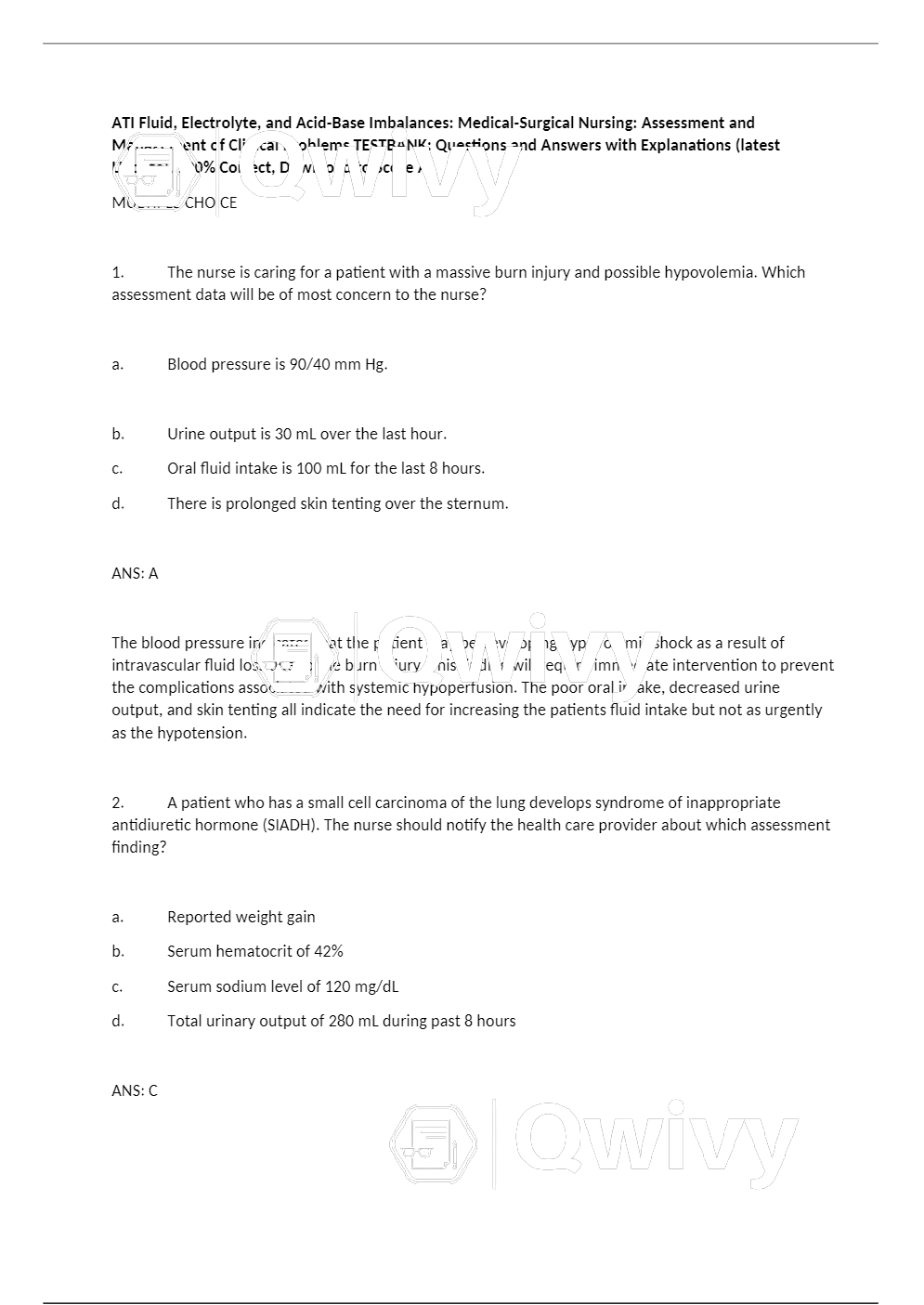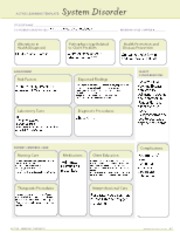Ati Fluid Electrolyte And Acid-Base Regulation
ATI Fluid Electrolyte And Acid-Base Regulation: A Comprehensive Guide
When it comes to nursing, understanding fluid, electrolyte, and acid-base balance is crucial. To help you navigate this complex topic, we've created a comprehensive guide to ATI Fluid Electrolyte And Acid-Base Regulation. This guide will provide you with all the essential information you need to know, including common imbalances, diagnostic tests, and nursing interventions. So, let's dive in!
1. An Overview of Fluid, Electrolyte, and Acid-Base Balance

Fluid, electrolyte, and acid-base balance are interconnected processes that play a vital role in maintaining homeostasis in the human body. Fluid balance refers to the equilibrium between fluid intake and output. Electrolytes are substances that conduct electrical impulses in the body and maintain various bodily functions. Acid-base balance involves regulating the pH levels in the body for optimal functioning of organs and systems.
Understanding the normal ranges and mechanisms of these balances is crucial in assessing and managing patients' health. Let's take a closer look at the imbalances that can occur and their potential causes.
2. Common Fluid, Electrolyte, and Acid-Base Imbalances

2.1 Hyponatremia: Low Sodium Levels
Hyponatremia occurs when the concentration of sodium in the blood is abnormally low. It can be caused by excessive sweating, kidney disorders, medications, or hormonal imbalances. Common symptoms include nausea, headache, confusion, and seizures. Treatment involves fluid restriction, sodium replacement, and addressing the underlying cause.
2.2 Hyperkalemia: High Potassium Levels
Hyperkalemia is characterized by abnormally high levels of potassium in the blood. It can occur due to kidney failure, certain medications, or excessive intake of potassium-rich foods. Symptoms may include muscle weakness, irregular heartbeat, and numbness. Treatment aims at stabilizing the cardiac rhythm and reducing potassium levels through diet modifications, medications, or dialysis if necessary.
2.3 Metabolic Acidosis: Excess Acid in the Body
Metabolic acidosis is a condition characterized by an excess of acid in the body. It can result from conditions such as uncontrolled diabetes, kidney disease, or severe diarrhea. Symptoms include rapid breathing, confusion, and fatigue. Treatment may involve addressing the underlying cause, administering bicarbonate, or intravenous fluids.
3. Diagnostic Tests for Fluid, Electrolyte, and Acid-Base Imbalances
To accurately diagnose fluid, electrolyte, and acid-base imbalances, various diagnostic tests are available. These tests help healthcare providers determine the underlying cause and guide appropriate treatment. Here are some commonly used diagnostic tests:
- Blood tests: These include electrolyte panels, arterial blood gas (ABG) analysis, and renal function tests.
- Urine tests: Urinalysis and urine electrolyte tests can provide valuable information about the body's fluid and electrolyte status.
- Imaging tests: In some cases, imaging studies like ultrasound or CT scans may be necessary to assess the function and structure of organs such as the kidneys.
It is essential for nurses to understand these diagnostic tests and their interpretation to provide effective care and interventions.
4. Nursing Interventions for Fluid, Electrolyte, and Acid-Base Imbalances
As a healthcare professional, nurses play a vital role in managing fluid, electrolyte, and acid-base imbalances. They implement various interventions to restore balance and promote optimal patient outcomes. Here are some common nursing interventions:
- Assessment and monitoring: Regular assessment of vital signs, intake and output, and laboratory values is essential for identifying imbalances and evaluating treatment effectiveness.
- Administration of medications: Nurses may administer medications such as diuretics, electrolyte replacements, or acid-base regulating drugs as prescribed by the healthcare provider.
- Patient education: Educating patients and their families about measures to maintain fluid and electrolyte balance, dietary modifications, and adherence to medication regimens is crucial for long-term management.
- Intravenous therapy: Nurses may initiate and monitor intravenous therapy to provide fluid and electrolyte replacement in severe imbalances or in cases where patients are unable to tolerate oral intake.
Remember, each patient's condition is unique, and interventions should be tailored accordingly to achieve the best possible outcomes.
FAQs (Frequently Asked Questions)
Q1: How can I prevent dehydration?
A1: To prevent dehydration, ensure an adequate intake of fluids throughout the day. Drink water, sports drinks, and other hydrating beverages. Avoid excessive consumption of caffeine and alcohol, as they can dehydrate the body. If you engage in physical activities or work outdoors, increase fluid intake to compensate for the extra loss through sweat.
Q2: Can I correct electrolyte imbalances through dietary changes alone?
A2: In some cases, mild electrolyte imbalances can be corrected through dietary modifications. However, it is crucial to consult with healthcare professionals to ensure appropriate management. Severe imbalances often require medical interventions and close monitoring.
Q3: How can I recognize symptoms of an acid-base imbalance?
A3: Symptoms of acid-base imbalances vary depending on the specific condition. However, common symptoms include changes in breathing patterns, fatigue, confusion, muscle weakness, and abnormal heart rhythms. If you experience any concerning symptoms, it is important to seek medical attention.
Q4: Are there any natural remedies for fluid, electrolyte, and acid-base imbalances?
A4: While certain herbal remedies and alternative therapies claim to help restore balance, it is crucial to consult with healthcare professionals before using them. Natural remedies may interact with medications or have inconsistent results. Always prioritize evidence-based medical advice.
In conclusion, understanding fluid, electrolyte, and acid-base regulation is essential for nursing practice. By familiarizing yourself with ATI Fluid Electrolyte And Acid-Base Regulation, you can enhance your knowledge and provide efficient care to patients with imbalances. Remember to regularly update your knowledge through evidence-based resources and continued professional development to deliver the best possible care.
For more information and detailed study materials, refer to the official ATI publications and resources. Best of luck in your nursing journey!
ATI RN TARGETED MED-SURG FLUID, ELECTROLYTE & ACID BASE 2019 Flashcards
 Image Source : quizlet.com
Image Source : quizlet.com NURSING - Ursuline College - Course Hero
 Image Source : www.coursehero.com
Image Source : www.coursehero.com ati ursuline nursing fluid balance hero course college pages acid base
ATI Fluid, Electrolyte, And Acid-Base Imbalances: Medical-Surgical
 Image Source : qwivy.com
Image Source : qwivy.com Gould Chapter 2_Fluid, Electrolyte, Acid-Base Imbalances.docx - Gould
 Image Source : www.coursehero.com
Image Source : www.coursehero.com electrolyte concept ati basic coursehero gould acid fluid chapter base imbalances pages docx
SOLUTION: ATI Engage Fundamentals - Fluid, Electrolyte, And Acid Base
 Image Source : www.studypool.com
Image Source : www.studypool.com Engage Fundamentals Fluid, Electrolyte, And Acid-Base | Chegg.com
 Image Source : www.chegg.com
Image Source : www.chegg.com 169 Ch 27_lecture_presentation
 Image Source : www.slideshare.net
Image Source : www.slideshare.net Signs Of Fluid Volume Deficit Ati - Slidesharetrick
 Image Source : slidesharetrick.blogspot.com
Image Source : slidesharetrick.blogspot.com fluid ati deficit excess slidesharetrick
169 ch 27_lecture_presentation. Engage fundamentals fluid, electrolyte, and acid-base. Fluid ati deficit excess slidesharetrick. Ati fluid, electrolyte, and acid-base imbalances: medical-surgical. Electrolyte concept ati basic coursehero gould acid fluid chapter base imbalances pages docx